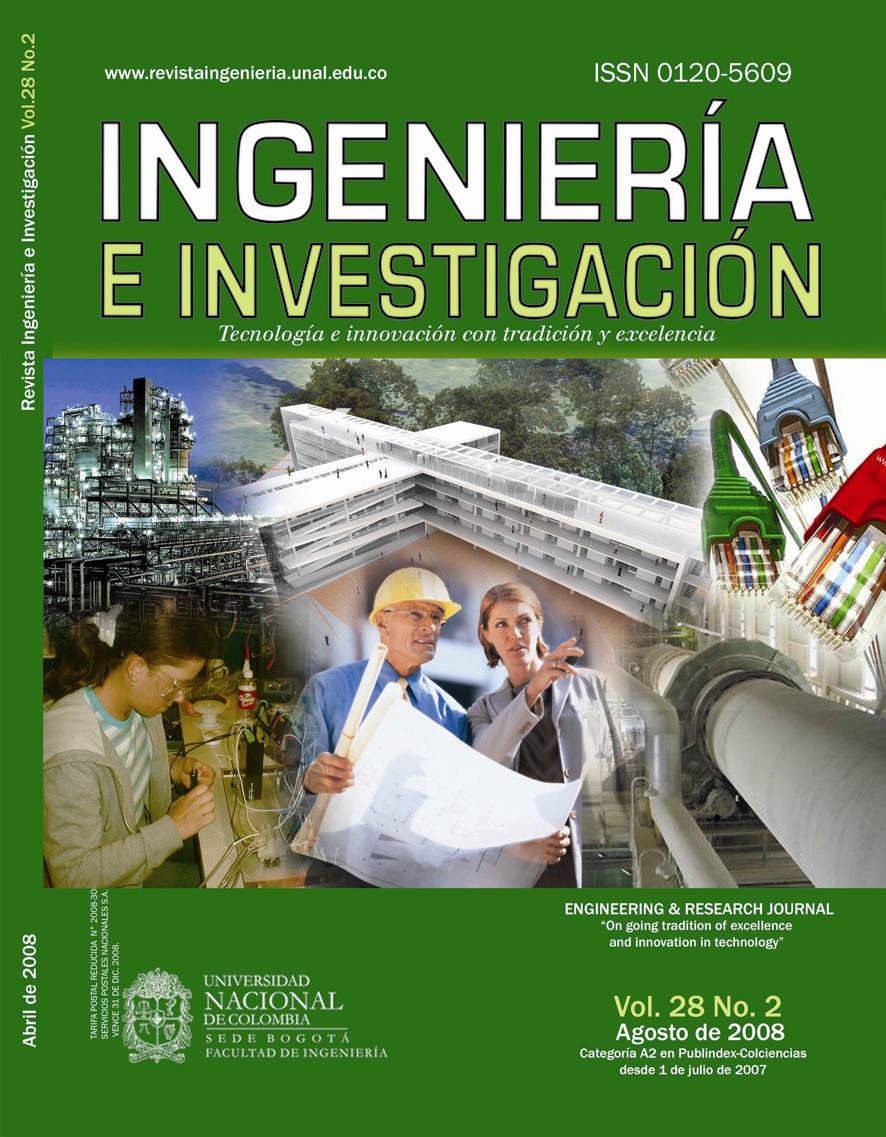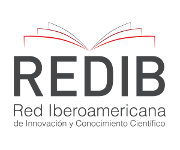Modelling the kinetics of thin-layer yam (dioscorea rotundata) drying
Modelado de la cinética de secado de ñame (dioscorea rotundata) en capa delgada
DOI:
https://doi.org/10.15446/ing.investig.v28n2.14891Keywords:
diffusion coefficient, Page, mathematical model (en)coeficiente de difusión, Page, modelos matemáticos (es)
Downloads
Thin-layer yam (varieties 9811-089 and 9811-091) drying was evaluated in a laboratory-type dish dryer at 45°C, 55°C and 70°C and 1 m/s average air speed in the Universidad de Cordoba’s Applied Engineering laboratory. The samples were 3.19 cm long, 0.5 cm thick, in 0.5x3x5 cm slices. The effects of temperature, variety and geometry on drying-time were evaluated using a completely random factorial adjustment design: temperature (45°C, 55°C and 70°C), geometry (slices and fillets) and variety (9811-089 and 9811-091). Three repetitions were made per treatment, producing a 28.15% reduction in drying time at 70°C. Drying curves were constructed from the obtained results; it was observed that drying took place during the decreasing period, proving that diffusion was the mechanism involved in Discorea rotundata drying for the studied varieties. Drying curves were adjusted to Page, diffusion, Thompson, Newton, modified Page, Henderson and Pabis mathematical models. The logarithmic model (determined by determination coefficient (R2)) estimated mean error (SE) and relative mean deviation (%P), showing that the logarithmic model better described the drying process (R2 ≥ 99.17 and SE ≤ 0.0299).
El secado de ñame en capa delgada, de las variedades 9811-089 y 9811-091, fue evaluado en un secador de laboratorio tipo bandeja a temperaturas de 45, 55 y 70 °C y velocidad de aire promedio de 1 m/s, en el Laboratorio de Ingeniería Aplicada de la Universidad de Córdoba; las muestras fueron adecuadas en geometría de rodajas de radio 3,19 cm y espesor de 0,5 cm y láminas de 0,5x3x5 cm. Se evaluó el efecto de la temperatura, variedad y geometría en el tiempo de secado, empleando un diseño completamente al azar en arreglo factorial con tres factores: temperatura (45, 55 y 70 °C), geometría (rodajas y láminas) y variedad (9811-089 y 9811-091), realizando tres repeticiones por tratamiento utilizando, dando como resultado una disminución en el tiempo de secado del 28,15% para la temperatura de 70 °C. Con los resultados obtenidos fueron construidas las curvas de secado, en las cuales se observó que este proceso tuvo lugar en el periodo decreciente, lo que evidencia que la difusión es el mecanismo que gobierna el secado de Dioscorea rotundata para las variedades estudiadas. Las curvas de secado fueron ajustadas a los modelos matemáticos de Page, difusión, Thompsom, Newton, Page modificado, Henderson y Pabis y el modelo logarítmico, determinando mediante el coeficiente de determinación (R2), error medio estimado (SE) y desvío medio relativo (%P), que el modelo logarítmico es el que mejor describe el proceso de secado (R2 ≥ 99.17 y SE ≤ 0.0299).
References
AOAC., Association of Official Analytical Chemist. Official methods of analysis., 16th edition. Washington, 1997, pp. 3005.
Babilis, S., Belessiotis, V. Influence of the drying constants and moisture diffusivity during the thin-layer drying of figs., Journal of food Engineering, Vol. 65, No. 3, 2004, pp. 449-458. DOI: https://doi.org/10.1016/j.jfoodeng.2004.02.005
Cardoso, F., Palmeira, J., Rodríguez, M., Honorato, F., ALVES, S. Comparación de modelos matemáticos de calor isotérmico de desorción en pulpa de Guayaba., Revista Brasileira de almacenamiento, Vol. 29, No. 1, 2004, pp. 28-34.
Chaves, M., Sgroppo, S., Avanza, J., Cinética de Secado de Berenjena (Solanum melongena L.)., Universidad nacional del nordeste. Comunicaciones científicas y tecnológicas. Corrientes–Argentina. Facultad de ciencias exactas y agrimensura, 2003, [Citado Oct-06-2006], Resumen E 60, Disponible en Internet: http://www.exa.unne.edu.ar.
Correa, P., Da Silva, P., Almeida, L., Estudo das propriedades físicas e de transporte na secagem de Cebola (Allium cepa L.) em camada delgada., Ciência y tecnología de los alimentos, Vol. 24, No. 3, 2004. DOI: https://doi.org/10.1590/S0101-20612004000300003
Doymaz, I., Pretreatment effect on sun drying of mulberry Fruits (Morusalba L)., Journal of food engineering, Vol. 65, No. 2, 2004, pp. 205-209. DOI: https://doi.org/10.1016/j.jfoodeng.2004.01.016
Doymaz, I., Drying characteristics and kinetics of Okra., Journal of food engineering, Vol. 69, No. 3, 2005, pp. 275-279. DOI: https://doi.org/10.1016/j.jfoodeng.2004.08.019
Ertekin, C., Yaldiz, O., Draying of eggplant and selection of a suitable thin layer drying model., Journal of food engineering, Vol. 63, No. 3, 2004, pp. 349-359. DOI: https://doi.org/10.1016/j.jfoodeng.2003.08.007
Falade, K., Olurin, T., Ike, E., Aworh, O., Effec of pre-treatment and temperature on air – Drying of Discorea alata and Discorea rotundata slices., Journal of food engineering, Vol. 80, No. 4, 2007, pp. 1002-1010. DOI: https://doi.org/10.1016/j.jfoodeng.2006.06.034
Fioreze, R., Morini, B. 2000. Yam (Dioscorea sp.) drying with different cuts and temperatures: experimental and simulated results. Ciênc. Tecnol. Aliment. Vol. 20, No. 2, 2000, pp. 262-266. DOI: https://doi.org/10.1590/S0101-20612000000200023
Geankoplis, C., Procesos de transporte y operaciones unitarias., 3a. edición. México: Compañía Editorial Continental S. A., 1998, pp. 1022.
Gögus, F., Maskan, M., Water adsorption and drying characteristics of Okra (Hibiscus esculentas L)., Drying Technology. Vol. 17, No. 4, 1999, pp. 883-894. DOI: https://doi.org/10.1080/07373939908917576
Guzmán, M., Buitrago, G., ÑAME: Producción de Semilla por Biotecnología., Santa fe de Bogotá: Unibiblos, 2000, pp. 17-20.
Maldoado, R., Pacheco, T., Curvas de deshidratación del Brócoli (Brassica Oleracea L. var Italica Plenk) y Coliflor (Brassica oleraceae L. var Botritis)., Revista de la Facultad de Agronomía, Universidad Central de Venezuela. Vol. 20, 2003, pp. 306-319.
Mohapatra, D., Rao, P., A thin layer drying model of parboiled wheat., Journal of food engineering. Vol. 66, No. 4, 2005, pp. 513-518. DOI: https://doi.org/10.1016/j.jfoodeng.2004.04.023
Nicoleti, F., Cinética de secado y encogimiento de rodajas de piña, Universidad estatal paulista. Campus de San José de Río prieto-Brasil. 2001
Ocampo, A., Modelo cinético del secado de la Pulpa de mango., Revista Escuela de Ingeniería de Antioquia EIA, Vol. 5, 2006, pp. 119-128.
Park, K., Vohnikova, Z., Reisbros, F., Evaluation of driying parameters and desorption isotherms of garden mint leaves (Mentha crispa L.)., Journal food Engineering, Vol. 51, 2002, pp. 193-199. DOI: https://doi.org/10.1016/S0260-8774(01)00055-3
Rincón, A., Evaluación del posible uso tecnológico de algunos tubérculos de las dioscoreas: Ñame congo (Dioscorea bulbífera) y mapuey (Dioscorea trífida)., Archivos Latinoamericanos de Nutrición. Vol. 50, No. 3, 2000, pp. 286-290.
Romero, L., Kieckbush, T., Influência de Condições de Secagem na Qualidade de Fatias de Tomate., Brazilian Journal of Food Technology, Vol. 6, No. 1, 2003, pp. 69- 76.
Rosello, C., Simal, S., San Juan, N., Nonostropic mass Transfer model for green Bean Drying., Journal of Agricultural and food Chemistry. Vol. 45, 1997, pp. 337- 342. DOI: https://doi.org/10.1021/jf960534c
Sandoval, S., Rodríguez, J., Méndez, L., Sánchez, J., Rapidez de secado reducida: Una aplicación al secado convectivo de plátano Roatán., Revista Mexicana de Ingeniería química, Vol. 5, No. 1, 2006, pp. 35-38.
Sierra, O., Munive, J., Determinación de las mejores condiciones del proceso de secado de dos variedades de ñame (D. alata 9506-021, 9506-027), para la obtención del mayor contenido de almidón., Trabajo de grado para optar al título de Ingeniero de alimentos, Universidad de Córdoba. Montería – Córdoba, 2007.
Simal, S., Femenia, M., Rosello, C., Use of exponential, Page and diffusional models to simulate the drying kinetics of Kiwi fruit., Journal of food Engineering. Vol. 43, 2005, pp. 109-114.
StatSoft, Inc., STATISTICA (data analysis software system)., 7.0, 2004, www.statsoft.com.
Vega, A., Fito, P., Modelado de la cinética de secado del pimiento Rojo (capsicum annuum L. cv Lamuyo)., In formación tecnológica, Vol. 16, No. 6, 2005, pp. 3-11. DOI: https://doi.org/10.4067/S0718-07642005000600002
Vega, A., Lemus, R., Modelado de la cinética de secado de papaya chilena (basconcellea pubescens)., Información tecnológica. Vol. 17, N° 3, 2006, pp. 23-31. DOI: https://doi.org/10.4067/S0718-07642006000300005
How to Cite
APA
ACM
ACS
ABNT
Chicago
Harvard
IEEE
MLA
Turabian
Vancouver
Download Citation
CrossRef Cited-by
1. Haydar Kucuk, Adnan Midilli, Aydin Kilic, Ibrahim Dincer. (2014). A Review on Thin-Layer Drying-Curve Equations. Drying Technology, 32(7), p.757. https://doi.org/10.1080/07373937.2013.873047.
2. Mónica Jimena Ortiz-Jerez, Angie Franco Sánchez, José Edgar Zapata Montoya. (2022). Drying kinetics and sensory characteristics of dehydrated pumpkin seeds (Cucurbita moschata) obtained by refractance window drying. Heliyon, 8(10), p.e10947. https://doi.org/10.1016/j.heliyon.2022.e10947.
Dimensions
PlumX
Article abstract page views
Downloads
License
Copyright (c) 2008 Everaldo Joaquín Montes Montes, Ramiro Torres Gallo, Ricardo David Andrade Pizarro, Omar Andrés Pérez Sierra, José Luis Marimon Escobar, Isabel Inés Meza Herazo

This work is licensed under a Creative Commons Attribution 4.0 International License.
The authors or holders of the copyright for each article hereby confer exclusive, limited and free authorization on the Universidad Nacional de Colombia's journal Ingeniería e Investigación concerning the aforementioned article which, once it has been evaluated and approved, will be submitted for publication, in line with the following items:
1. The version which has been corrected according to the evaluators' suggestions will be remitted and it will be made clear whether the aforementioned article is an unedited document regarding which the rights to be authorized are held and total responsibility will be assumed by the authors for the content of the work being submitted to Ingeniería e Investigación, the Universidad Nacional de Colombia and third-parties;
2. The authorization conferred on the journal will come into force from the date on which it is included in the respective volume and issue of Ingeniería e Investigación in the Open Journal Systems and on the journal's main page (https://revistas.unal.edu.co/index.php/ingeinv), as well as in different databases and indices in which the publication is indexed;
3. The authors authorize the Universidad Nacional de Colombia's journal Ingeniería e Investigación to publish the document in whatever required format (printed, digital, electronic or whatsoever known or yet to be discovered form) and authorize Ingeniería e Investigación to include the work in any indices and/or search engines deemed necessary for promoting its diffusion;
4. The authors accept that such authorization is given free of charge and they, therefore, waive any right to receive remuneration from the publication, distribution, public communication and any use whatsoever referred to in the terms of this authorization.



























